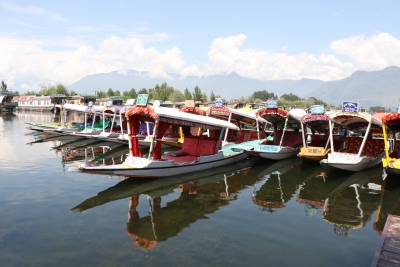Birth of the Perennial Land of Srinagar
By IANS | Published: October 8, 2021 11:48 PM2021-10-08T23:48:07+5:302021-10-09T00:00:15+5:30
Srinagar, Oct 8 Srinagar's beauty is grander than its lofty mountainous backdrop, deeper than its five lakes, and ...

Birth of the Perennial Land of Srinagar
Srinagar, Oct 8 Srinagar's beauty is grander than its lofty mountainous backdrop, deeper than its five lakes, and mesmerising than its forever flowering meadows.
Its charm and grandeur have inspired eras of artists for eons. Its beauty lies in the simplicity and romance that it offers so graciously to the visitors. Time stands still drinking a cup of warm 'Kehwa' on a crispy sunny day sitting on a boat when the beat of your heart synchronises with the rowing water of the Dal Lake.
Srinagar is a dimension in itself, an experience built to soothe and relax, blessed by celestial beings to be one of a kind, forever.
More than two thousand years ago, a mile to the south of Shankaracharya Hill, one of the oldest capitals in the world, 'Srinagar', was founded. The present city was founded by Pravarasena II (about AD 580) around the Sharika Hill, today known as Hariparbat.
Some historian accounts suggest that King Ashoka of the Gonandiya dynasty, the great-grandson of Shakuni, built a great city called 'Srinagara' (near, but not the same as modern-day Srinagar) during his reign in Kashmir.
The name of this city was first mentioned in Rajatarangini; Kashmir had many capitals, but 'Srinagari' was the most important of them all. 'Srinagari' is composed of two words 'Sri' meaning 'The Sun', and 'Nagari' meaning 'The City'; therefore, The City of The Sun.
When the disciple of Vikramaditya, Matrgupta, gave up his throne, Pravarasena was next in line. He had a great ambition - to build a timeless city that would memorialise him forever.
He was on a quest to find the perfect site and his longing left him anxious and restless. One night he walked north along the banks of river Vitasta (Jhelum) and out of nowhere rose a monstrous figure across the river that let out a hearty laugh to rattle the king. But the king's stature did not flinch. The giant, impressed by the valiance of the king, said, "Come with me and I will answer all your queries". He extended his leg and bridged the river Mahasarit (today known as Tsunti Kul) for the king.
He told the king he is Vetal, a Bhairva (a frightful manifestation of Shiva associated with annihilation) - a slave of the Almighty Lord Shiva. He also revealed to him that his desired land is in the North, a vast stretch of red clay that would last through alterations of time.
Following Bhairava's instructions, Parvarasena found his land at the foothills of Hariparbat. The work began with a temple at the centre of the city dedicated to Lord Shiva. The present-day site suggests that the temple was built by the present-day location of Ziarat Bahaud-Din Sahib.
The Dal Lake did not exist at that point in time, but a meadow named Vetalinimarg stood in its place; later it is said that an earthquake broke open the meadow, paving way for water which converted the large stretch of the area into a lake.
To combat the problem of water, the king diverted the course of the Vitasta. A wall was raised by sinking boats filled with soil and stones in the deep river bed. Today the place is known as Nawapora - the home of boats, 'naav' meaning boats. Using boats as the base, Pravarasena constructed the first of the seven bridges of Srinagar.
Hariparbat became the centre of attraction and offered a panoramic view of the picturesque city, its gardens and moors, hills and ravines, and the Dal Lake, acting as a centre point between the earthly and heavenly delights. He was successful in building his city, Pravapura, with which only a few could compete.
Lastly, to protect his city from dangers known and unknown to man, he invoked the help of gods and His men, and in Their name raised temples and shrines, dedicating huge stretches of land to the deities and large sums of money for the preservation of these places of worship.
Five of his major temples which display unmatched beauty of the valley are: (i) Maheshwari, near which Sultan Sikander built the Jama Masjid; (ii) Lokeshwari, unfortunately, converted to a burial ground for Kashmiri Sultans and now known as Badshah tomb; (iii) Parveshwari, near Pokhribal; (iv) Kalishwari, sadly closed down and in its place, Khanaqahi Muala was raised; (v) Sadbhavaashri, regrettably now converted to the tomb of Sultan Qutub-ud-din.
In the ode to the Bhairavas, who promised to protect the city, eight shires were also constructed. New capitals were found by the eminent kings Lalitaditya, Jayapida, Avantivarman, and Shankarvarman. The glories of their cities Parihasapura, Jayapura, Avantipura, and Shankarpatan have worn down with time. But Pravapura, the city of Pravarasena, has stood the test of time, though it lost its old name and assumed the name of the old city of Srinagari.
During the Islamic rule (1320-1819), the capital city was called Shahr-i-Kashmir. But post 1819 during the Sikh rule, the old name was restored with a little change - 'Srinagar.' Empires have risen and fallen to rubble but Pravasena's city continues to be the torchbearer for future generations, truly immemorial as the Gods made it.
Disclaimer: This post has been auto-published from an agency feed without any modifications to the text and has not been reviewed by an editor
Open in app